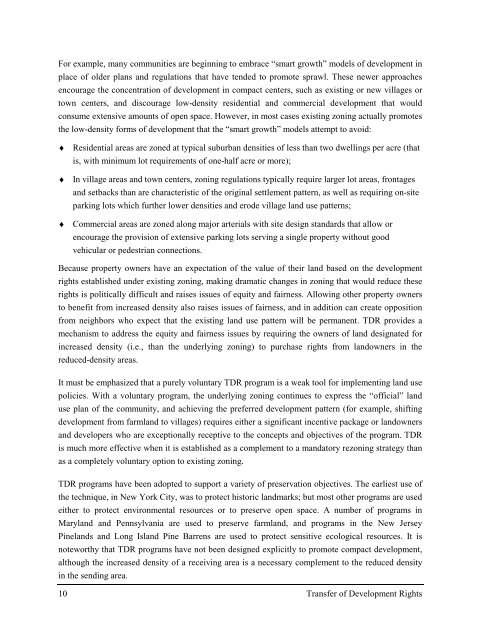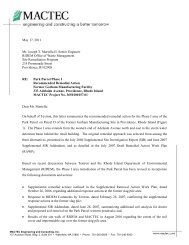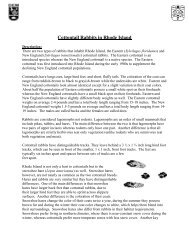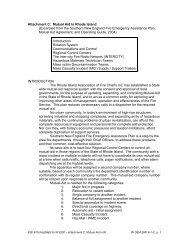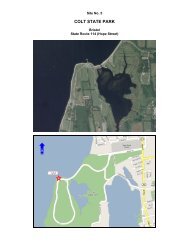Transfer of Development Rights Report - Rhode Island Department ...
Transfer of Development Rights Report - Rhode Island Department ...
Transfer of Development Rights Report - Rhode Island Department ...
You also want an ePaper? Increase the reach of your titles
YUMPU automatically turns print PDFs into web optimized ePapers that Google loves.
For example, many communities are beginning to embrace “smart growth” models <strong>of</strong> development in<br />
place <strong>of</strong> older plans and regulations that have tended to promote sprawl. These newer approaches<br />
encourage the concentration <strong>of</strong> development in compact centers, such as existing or new villages or<br />
town centers, and discourage low-density residential and commercial development that would<br />
consume extensive amounts <strong>of</strong> open space. However, in most cases existing zoning actually promotes<br />
the low-density forms <strong>of</strong> development that the “smart growth” models attempt to avoid:<br />
♦ Residential areas are zoned at typical suburban densities <strong>of</strong> less than two dwellings per acre (that<br />
is, with minimum lot requirements <strong>of</strong> one-half acre or more);<br />
♦ In village areas and town centers, zoning regulations typically require larger lot areas, frontages<br />
and setbacks than are characteristic <strong>of</strong> the original settlement pattern, as well as requiring on-site<br />
parking lots which further lower densities and erode village land use patterns;<br />
♦ Commercial areas are zoned along major arterials with site design standards that allow or<br />
encourage the provision <strong>of</strong> extensive parking lots serving a single property without good<br />
vehicular or pedestrian connections.<br />
Because property owners have an expectation <strong>of</strong> the value <strong>of</strong> their land based on the development<br />
rights established under existing zoning, making dramatic changes in zoning that would reduce these<br />
rights is politically difficult and raises issues <strong>of</strong> equity and fairness. Allowing other property owners<br />
to benefit from increased density also raises issues <strong>of</strong> fairness, and in addition can create opposition<br />
from neighbors who expect that the existing land use pattern will be permanent. TDR provides a<br />
mechanism to address the equity and fairness issues by requiring the owners <strong>of</strong> land designated for<br />
increased density (i.e., than the underlying zoning) to purchase rights from landowners in the<br />
reduced-density areas.<br />
It must be emphasized that a purely voluntary TDR program is a weak tool for implementing land use<br />
policies. With a voluntary program, the underlying zoning continues to express the “<strong>of</strong>ficial” land<br />
use plan <strong>of</strong> the community, and achieving the preferred development pattern (for example, shifting<br />
development from farmland to villages) requires either a significant incentive package or landowners<br />
and developers who are exceptionally receptive to the concepts and objectives <strong>of</strong> the program. TDR<br />
is much more effective when it is established as a complement to a mandatory rezoning strategy than<br />
as a completely voluntary option to existing zoning.<br />
TDR programs have been adopted to support a variety <strong>of</strong> preservation objectives. The earliest use <strong>of</strong><br />
the technique, in New York City, was to protect historic landmarks; but most other programs are used<br />
either to protect environmental resources or to preserve open space. A number <strong>of</strong> programs in<br />
Maryland and Pennsylvania are used to preserve farmland, and programs in the New Jersey<br />
Pinelands and Long <strong>Island</strong> Pine Barrens are used to protect sensitive ecological resources. It is<br />
noteworthy that TDR programs have not been designed explicitly to promote compact development,<br />
although the increased density <strong>of</strong> a receiving area is a necessary complement to the reduced density<br />
in the sending area.<br />
10 <strong>Transfer</strong> <strong>of</strong> <strong>Development</strong> <strong>Rights</strong>


